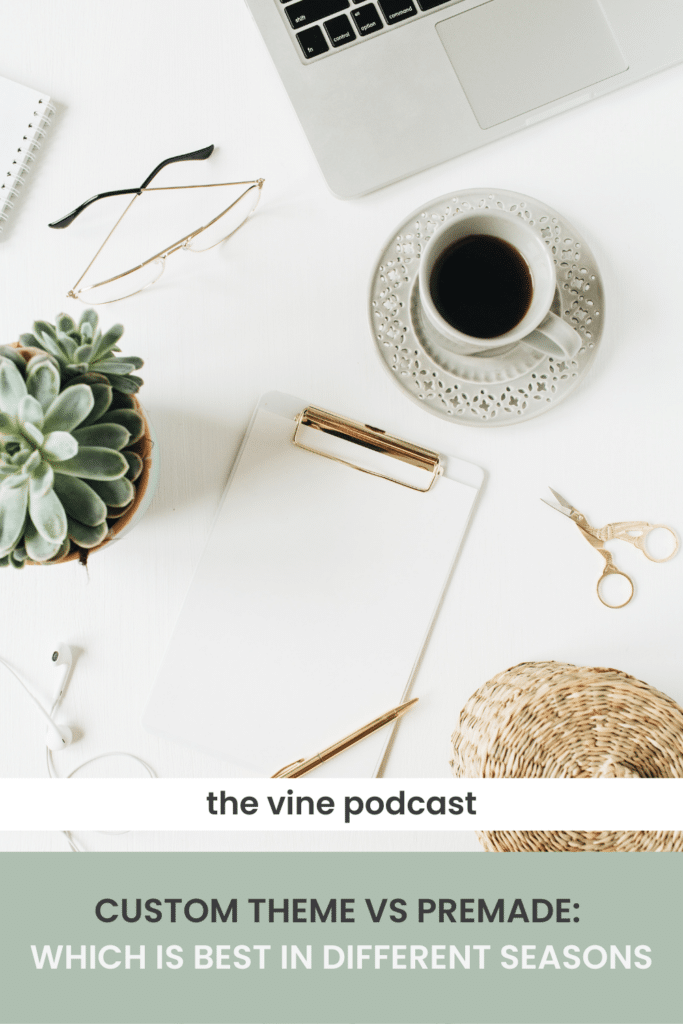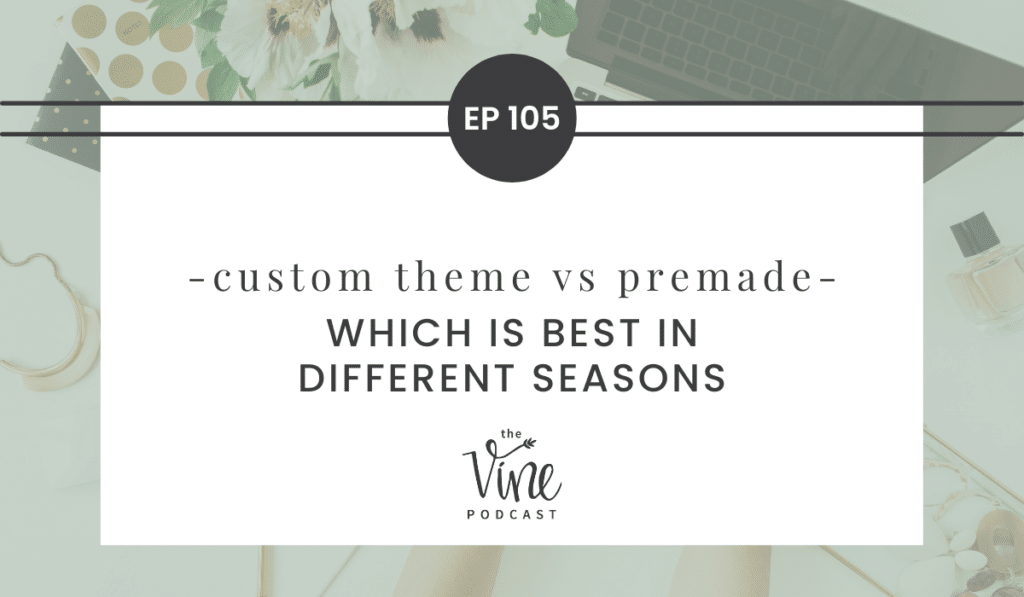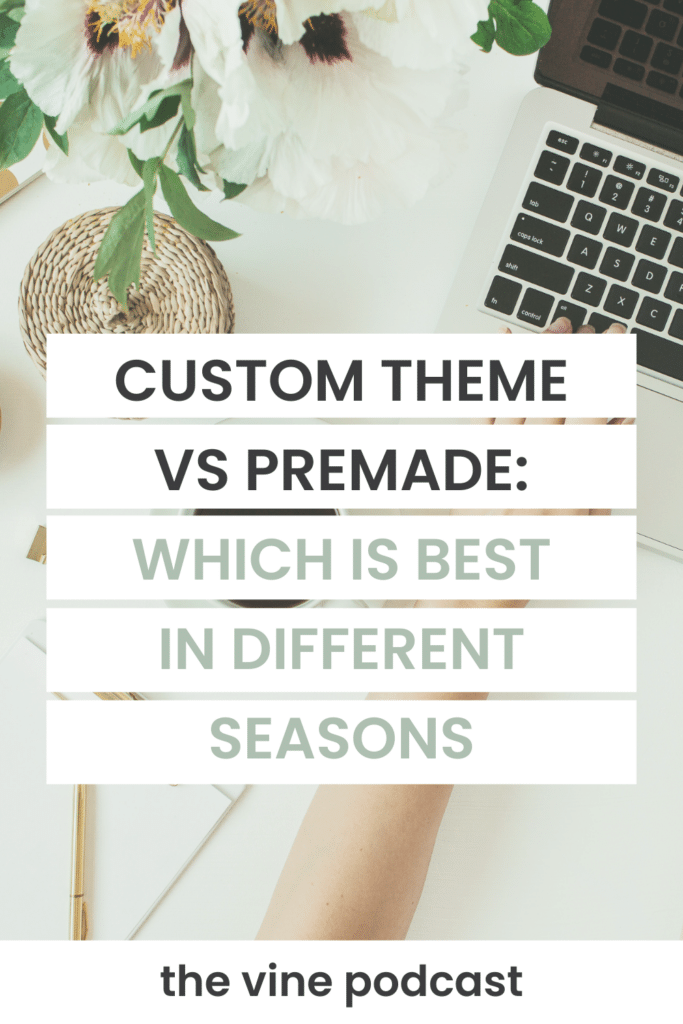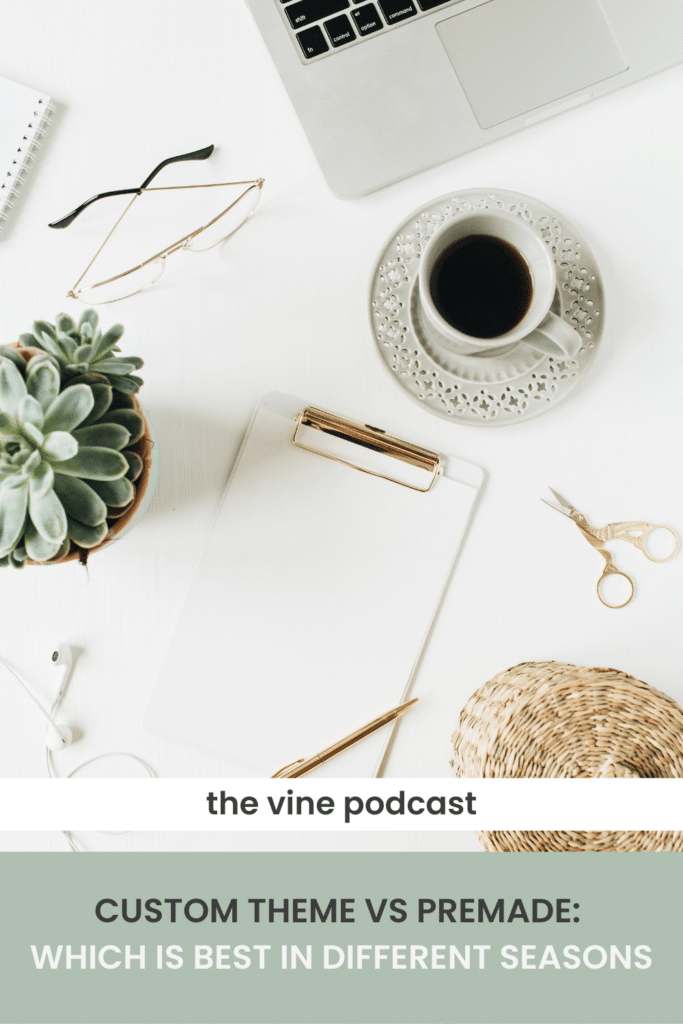Have you ever wondered what the difference is between a premade theme and a custom theme? Well, today’s episode is perfect for you. This is a topic that I have had on my list for such a long time and when it comes down to it, I wanted to be able to share from an unbiased perspective when it comes to this topic of themes. The truth is that there are times when a premade theme is perfect for a food blogger and times when a custom theme might be a better option. I know for so many of you, you have wondered whether a premade theme is good enough for your blog, or whether you need a custom theme. Or maybe you’re wondering when the right time is to invest in something like a custom theme. I’m excited to break down the pros and cons of both types of themes and ultimately, how you can decide what is best for the season that your blog is in right now.


I wanted to go ahead and just define what I mean by these two terms in case you are not familiar. A premade theme is something you’re going to buy from another vendor online. Someone who is selling a theme to you where you download a file, and you install it onto your WordPress site. On the other side, a custom theme is something that is being built from scratch for you. It has been coded from scratch for you and your needs 99% of the time. I want to just go ahead and put this disclaimer out there that I am not against premade themes at all, even as somebody who builds custom websites and custom themes for our clients. I think there is a really good time and season for using a premade theme. I think there are times when a custom theme is just not something that your site needs and so we’re going to talk about that today.
Pros of a Premade Theme
Let’s dive into the benefits of a premade theme. I think a premade theme is best fit for someone who is just getting started on their blog, or who has under 50,000 sessions per month. The third sort of qualifier is somebody who might not have a lot of content yet. So maybe you’ve had your blog for a while, but you still have 40 to 50 blog posts on your site, or maybe it’s somewhere under 100 blog posts. We see that the clients who have much more content than this are going to benefit more from a custom site than someone who has less content. Again, on a case-by-case basis, it just depends on the person, and how invested they are into their blog.
One of the first benefits of a premade theme is that they are really battle tested for a wide range of devices and use cases. What I mean by this is that they’re really meant to work for a lot of different scenarios. They’ve been tested in a lot of different environments with a lot of different users and different blogs trying to use the theme. Another benefit is that they are maintained and updated by experts. This means that the developer of the theme originally is going to be looking for ways that they can enhance and update their theme to keep it compliant, to keep it up to speed with what food bloggers are needing and they’re making those changes. The only downside to this is that you’re going to need a developer or someone who is tech savvy enough to be able to implement those changes, because it’s not like you’re going to just install a brand-new theme. Most of the time, you’re having to go in and update the theme, while trying to maintain your customizations that you’ve already made.
It’s also less complex to set up and to launch and so most of the time, there’s going to be a lot of documentation of this. It’s something that you can do on your own versus a custom theme that most people are not going to have the knowledge to create a custom theme and develop that from scratch. A premade theme is almost always a lower investment than a custom theme which is why this is a great option for someone who is just getting started and doesn’t have or want to invest a ton of money into their new site. A lot of the time a premade theme is going to include some level of support, and this will vary widely depending on what the developer has chosen to do. There have unfortunately been a lot of themes that are created and then never updated and there is no support for them. But again, the good themes in the food blogging space do have a little bit of support included, and these are going to be able to have somebody who can help troubleshoot issues that you might be having.
This theme is generally going to be designed to be one size fits all. So really the developer of the theme is thinking about what the majority of food bloggers are going to need and they’re creating a theme that is going to fit that need. Again, this is great for someone just getting started who might not know quite yet what they need. They’re going to be set up for success by having a site and a theme that is built to help them get started and help them to focus on creating content, not trying to figure out how to design their own website.
Then the final benefit is that these themes are often designed and developed to allow you to really plug and play and quickly be able to get set up using a lot of examples and demos. You’re really going to be able to set up a theme that matches what they have designed as their demo already and be able to get that started relatively quickly.
Cons of a Premade Theme
Now let’s talk about some of the downsides of premade themes. I alluded to some of these in some of the benefits as some of the benefits really do have a negative side to them. One downside is that some themes will stop being supported after a year that they come out. The food blogging industry changes so much that not having any updates or any support after a year can be problematic because things change on a daily basis in the food blogging industry. So again, a good premade theme is going to have that support and those updates that are going to be maintained. But a lot of themes unfortunately do not have that and it’s rare to find ones that do.
Another potential downside is that those updates that the developer may or may not be making can sometimes cause more things to break on the site and can just cause more problems. Every single site is different and even if you have the exact same theme, you have different plugins, you have different hosting companies. So, there are a million different things that can be different and can cause things to act differently when you go and try to update something. Now, especially if you’re using a premade theme that is not on a parent theme, like Genesis Astra, Generate Press, or Kadence, it is going to be a lot of work to keep these things updated. A parent theme essentially allows you to apply what’s called a child theme, which is going to have all your styling and effects and so you can update those parent theme cores with whatever updates are coming out, without affecting the child theme styling. For example, the Foodie Pro theme, when an update comes out for Genesis, it’s not going to wipe out all your changes and things that you’ve done to the Foodie Pro theme to make it custom. But if you’re not using a parent theme/child theme combo like that, you could run into issues where things are getting wiped out when you try to update them.
One of the biggest downfalls to premade themes is that your brand can and most likely will look like the other sites that are in your niche. I cannot even tell you how many times I have heard this complaint from potential clients, who say they don’t love that their site looks like everybody else’s, because it’s using the same theme. It’s easy for sites to become cookie cutter like, when they’re all using the same theme, especially when you are not taking the time or investing into having it customized to match your brand. It’s very easy for a lot of these sites to look almost the same except for the logo at the top.
Now, if you want to customize it and you want it to look different, you’re going to have to use custom blocks, short codes, custom plugins, a lot of different things, to be able to try to make it look like it is outside of the box and not just looking like the theme developers’ options that they gave you. However, the theme is not always going to support those things that you are trying to implement and so that can cause problems. Plus, not every theme is going to be compatible with every single plugin. Whereas on the opposite side, when you are working with a designer or developer to build a custom theme, all those things are being tested and you could still run into that same issue in the future. But because you’re building it together and you’re making those decisions from the beginning, it’s less likely that you’re going to add something down the road, that’s going to cause a conflict, because you’ve already made that strategic decision about what you need to use at the beginning.
To recap, premade themes are going to be great for someone who has a lower budget or as a brand-new site, because it will allow you to focus on writing content. That’s not to say that a premade theme can never be good for somebody who is maybe not on a lower budget or doesn’t have a brand-new site. But in general, you’ll see that some of these pros and cons are going to lead you to want to use a premade theme when you are just getting started.
Pros of a Custom Theme
When it comes to a custom theme, I am talking about really investing into the experience and the process of working with a designer to build a custom theme. I am not necessarily talking about something where you are just hiring some random person on Fiverr to build you a theme. I really truly believe when you take out the strategy from what you are doing, it’s going to make it hard to reach the goals that you want your site to reach.
With a custom theme, you’re going to have a well thought out user experience and user interface design. When you work with a developer or a designer to build a custom theme, you’re also going to have their expertise and they’re going to be able to share their knowledge and help you to navigate through design decisions. So, you’re not going to be just choosing something that you like or what looks good to you, you’re really going to have the thought and strategy behind it when you make those intentional decisions. You will have something that is customized to your brand, and I mean this both in the strategy and in the design. There are no two client sites of ours that have both the same strategy and the same design features to them. This is again, a huge difference in premade versus custom because premade you have some options to be able to move things around and customize them to you a little bit. But for the most part, you’re following a template, you’re following what somebody else has decided is the strategy for your brand instead of creating a strategy around your brand, what your audience needs and who you are trying to serve through your content.
A custom theme is going to give you that one of a kind look and functionality that is really designed to create a unique and memorable experience for your readers. You’re going to have custom features that are built into your unique needs, so things like custom Gutenberg blocks that are going to make it easy for you to create your posts, add your helpful tips into your posts and add information that your readers are really needing and looking for. You’re going to have custom recipe cards that stand out and have unique custom fields. You’re going to be able to just really have something that is true to your brand and unique to your brand, that cuts out all the fluff that you don’t need to have and that just really adds in the things that will enhance someone’s experience on your site.
With a custom theme, you’re also going to have that professional and polished design on all the devices. Nowadays, mobile really must be the first thought when you’re designing and if it is, you’re really going to be creating an experience that is the same on all devices. So not sacrificing something just for desktop or just for mobile, but really being able to create that seamless experience, where you create a way for people to use your site based on the device that they are using, because you understand how responsive design works. This is important to remember too when you are potentially looking for a designer. They need to understand and prioritize that not only in the execution of your site, but also in the strategy and the intentionality behind your site as well.
One of the biggest benefits to a custom theme is that there’s no tech or development work for you that makes you want to pull your hair out. Clients still must do quite a bit of homework to get ready for their project, and they will be spending time giving us feedback and content for their blog. But as far as the tech or development work, they leave that to us, and we can take care of that for them.
Cons of a Custom Theme
One of the downsides of a custom theme is that it is a bigger investment and if you are paying, you know, $100 or $200 for a custom theme, it’s probably not custom. If you’re paying what you would pay for a premade theme, it’s probably not what you’re expecting it’s going to be and the work that goes into a custom theme warrants it being much more expensive than a premade theme. Remember, a premade theme is going to be rinsed and repeated, it’s going to be something that gets purchased over and over and over again, and it is not custom in the sense that a custom theme is.
The process of building a custom theme and working with a designer takes a lot more time than it does to just set up a theme. So, it’s something that you must plan for, to plan for that design period. So, for any really good designer/developer combo, you’re really going to be looking at that six to eight week mark, and I have seen up to 12 to 16 weeks. This is really something that must be part of your plan for the year that you are thoughtfully considering and planning when the best time would be.
Now another potential custom theme downside is that they can be difficult to update. This is especially true when you are not working with somebody who is thinking about how you’re going to need to update your site in the future. I’ve had so many stories from clients who have come to us saying that they invested all this money into a custom site and now they can’t make any updates to it.
As a food blogger, you just need more flexibility than that. and it is important to be able to make changes to your site. But that can often be a downside to a custom theme and it’s a question that you should be asking someone who you are considering working with.
On that note too, you could have a site that is overly customized and becomes way too heavy and will potentially have an impact on your core web vitals or your site performance overall. This is a part of the reason why we have added in our Site Speed Audit and Review into our client process because it is so important for food bloggers to have a site that is functional, beautiful, and passes all the things that needs to pass for site speed.
Deciding Which is Right for You
So now with those things in mind, it’s time to decide which theme is right for you. One thing I will say is that if listening to this, you felt a gut instinct telling you that a premade theme was right for you, or a custom theme was right for you, then lean into that because your first instinct about this is important. However, there’s some other things that you need to factor into your decision too, such as your budget. Is a custom theme, something that you can afford right now? Are you really needing to get your site up and running as soon as possible? Maybe you have something that is breaking on your site, and you’re not able to use it right now.
Another thing to consider is what other things you have going on right now. We’ve had clients who have scheduled their design process around a move or a big trip or a maternity leave, different things like that. It’s also important to think about what the best time of year to update your site is. We’ve got clients who quarter one is their best season of the year and so we don’t work on their project during that time. Some other more traditional food bloggers may see a big spike in quarter four and so we avoid updating their site during that time.
In using a premade or custom theme, I don’t really feel like there is a right answer in all scenarios. Every single site is going to be totally different. The common things that we hear from our clients that lead them to a custom theme are that premade themes can look very cookie cutter. They are really looking for something that stands out and is unique and represents their brand. They want to put the time into creating a strategy for their brand and for their website, so they can really create that user experience that they are looking for on their site.
If after listening to this, you’re still not sure what would be the right thing for you and you’re still considering a custom site, but still not quite sure about it, reach out and chat with us. Go over to our website, click on the Services tab and click on the web design portion so that you can schedule a call and we can chat through what would be the best thing for your site right now. Often, the clients who are wanting a custom site, find it really is the best fit for them. It’s just a matter of whether it’s the best fit right now or if it needs to be something that they put on their to do list for later down the road.
If you have another question about the difference or a pro or a con that I mentioned, feel free to reach out over on Instagram and chat with me about it there. I hope that there can be less of a “me versus them” approach when it comes to premade themes versus custom themes, as there are scenarios where one is better than the other. I hope that this honest approach will help you to see what the best fit for you is. Even as a designer, I can still see the benefits to a premade theme in certain situations and for certain audiences and certain blogs.

ready to take your food blog to the next level?
We work with food bloggers looking to stand out of the crowd through custom brand and website design.
Call to Action
Share the call to action for this episode and what their next steps are.
Stay up to date on all things food blogging
This industry moves quickly – stay up to date on the latest trends & tips for growing your food blog with intention.
Pin for later
Come browse my Pinterest for more inspiration >>






Hi Madison & team!
I’ve been listening to your podcast and absolutely love what you do!
I was wondering if you’d be able to help with my particular design need. I’m in a pretty unique spot where I already have an established business, website, and Instagram presence.
This year though, I really want to turn my website into much more of a food blog. The thing is though – I already have an established website on Wix that I do not want to move off of. I sell digital cookbooks through Wix, and moving to another platform at this time just isn’t something I really want to consider, since all my sales data and customer info is there.
I was wondering if any of your services would offer food blog design on Wix. I have tried so many times to design a food blog template that I’m happy with, and I’m just not succeeding! I understand that is a super specific need, so if this isn’t something you offer, no worries at all. I just thought it would be worth asking!
Thank you in advance for your time!
Annika